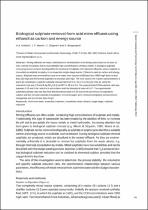 ResearchSpace
ResearchSpace
Biological sulphate removal from acid mine effluent using ethanol as carbon and energy source
JavaScript is disabled for your browser. Some features of this site may not work without it.
- ResearchSpace
- →
- Research Publications/Outputs
- →
- Journal Articles
- →
- View Item
| dc.contributor.author |
Greben, HA

|
en_US |
| dc.contributor.author |
Maree, JP

|
en_US |
| dc.contributor.author |
Singmin, Y

|
en_US |
| dc.contributor.author |
Mnqanqeni, S

|
en_US |
| dc.date.accessioned | 2007-03-28T08:47:46Z | en_US |
| dc.date.accessioned | 2007-06-07T10:07:20Z | |
| dc.date.available | 2007-03-28T08:47:46Z | en_US |
| dc.date.available | 2007-06-07T10:07:20Z | |
| dc.date.copyright | en_US | |
| dc.date.issued | 2000 | en_US |
| dc.identifier.citation | Greben HA, et al. 2000. Biological sulphate removal from acid mine effluent using ethanol as carbon and energy source. Water Science and Technology, vol. 42, 04 March, pp 339-344 | en_US |
| dc.identifier.issn | 0273-1223 | en_US |
| dc.identifier.uri | http://hdl.handle.net/10204/2153 | en_US |
| dc.identifier.uri | http://hdl.handle.net/10204/2153 | |
| dc.description.abstract | Mining effluents are major contributors to mineralization of receiving waters and can be toxic to man, animals and plants due to unacceptably high concentrations of heavy metals. A biological sulphate removal process has been developed for the treatment of sulphate-rich industrial effluents, where sulphate is converted via sulphide to sulphur in an anaerobic single-stage reactor. Ethanol is used as carbon and energy source. Sulphate was removed from acid mine water over a period of 95 days from 3000 mg/l down to less than 200 mg/l and the formed sulphides to less than 200 mg/l. The VSS value in the reactor varied between 3 and 4 g/l, resulting in a specific sulphate removal rate from 0.47 to 2.47 g SO4/(g VSS.d), while the volumetric rate was 2.5 and 8.4g SO4/(2.d) at HRT of 18 to 4.3 h. The experimental COD/sulphate ratio was between 0.55 and 0.84, which is in accordance with the theoretical value of 0.87. The experimental sulphide/sulphate ratio was less than the theoretical value of 0.33 due to the conversion of sulphate to sulphur and due to metal sulphide precipitation. Iron and copper were removed completely and aluminium, manganese and zinc to less than 4 mg/l. | en_US |
| dc.format.extent | 66312 bytes | en_US |
| dc.format.mimetype | application/pdf | en_US |
| dc.language.iso | en | en_US |
| dc.publisher | I W A Publishing | en_US |
| dc.rights | Copyright: 2000 I W A Publishing | en_US |
| dc.source | en_US | |
| dc.subject | Acid mine water | en_US |
| dc.subject | Anaerobic treatment | en_US |
| dc.subject | sulphate reduction | en_US |
| dc.subject | Engineering | en_US |
| dc.title | Biological sulphate removal from acid mine effluent using ethanol as carbon and energy source | en_US |
| dc.type | Article | en_US |
| dc.identifier.apacitation | Greben, H., Maree, J., Singmin, Y., & Mnqanqeni, S. (2000). Biological sulphate removal from acid mine effluent using ethanol as carbon and energy source. http://hdl.handle.net/10204/2153 | en_ZA |
| dc.identifier.chicagocitation | Greben, HA, JP Maree, Y Singmin, and S Mnqanqeni "Biological sulphate removal from acid mine effluent using ethanol as carbon and energy source." (2000) http://hdl.handle.net/10204/2153 | en_ZA |
| dc.identifier.vancouvercitation | Greben H, Maree J, Singmin Y, Mnqanqeni S. Biological sulphate removal from acid mine effluent using ethanol as carbon and energy source. 2000; http://hdl.handle.net/10204/2153. | en_ZA |
| dc.identifier.ris | TY - Article AU - Greben, HA AU - Maree, JP AU - Singmin, Y AU - Mnqanqeni, S AB - Mining effluents are major contributors to mineralization of receiving waters and can be toxic to man, animals and plants due to unacceptably high concentrations of heavy metals. A biological sulphate removal process has been developed for the treatment of sulphate-rich industrial effluents, where sulphate is converted via sulphide to sulphur in an anaerobic single-stage reactor. Ethanol is used as carbon and energy source. Sulphate was removed from acid mine water over a period of 95 days from 3000 mg/l down to less than 200 mg/l and the formed sulphides to less than 200 mg/l. The VSS value in the reactor varied between 3 and 4 g/l, resulting in a specific sulphate removal rate from 0.47 to 2.47 g SO4/(g VSS.d), while the volumetric rate was 2.5 and 8.4g SO4/(2.d) at HRT of 18 to 4.3 h. The experimental COD/sulphate ratio was between 0.55 and 0.84, which is in accordance with the theoretical value of 0.87. The experimental sulphide/sulphate ratio was less than the theoretical value of 0.33 due to the conversion of sulphate to sulphur and due to metal sulphide precipitation. Iron and copper were removed completely and aluminium, manganese and zinc to less than 4 mg/l. DA - 2000 DB - ResearchSpace DP - CSIR KW - Acid mine water KW - Anaerobic treatment KW - sulphate reduction KW - Engineering LK - https://researchspace.csir.co.za PY - 2000 SM - 0273-1223 T1 - Biological sulphate removal from acid mine effluent using ethanol as carbon and energy source TI - Biological sulphate removal from acid mine effluent using ethanol as carbon and energy source UR - http://hdl.handle.net/10204/2153 ER - | en_ZA |





